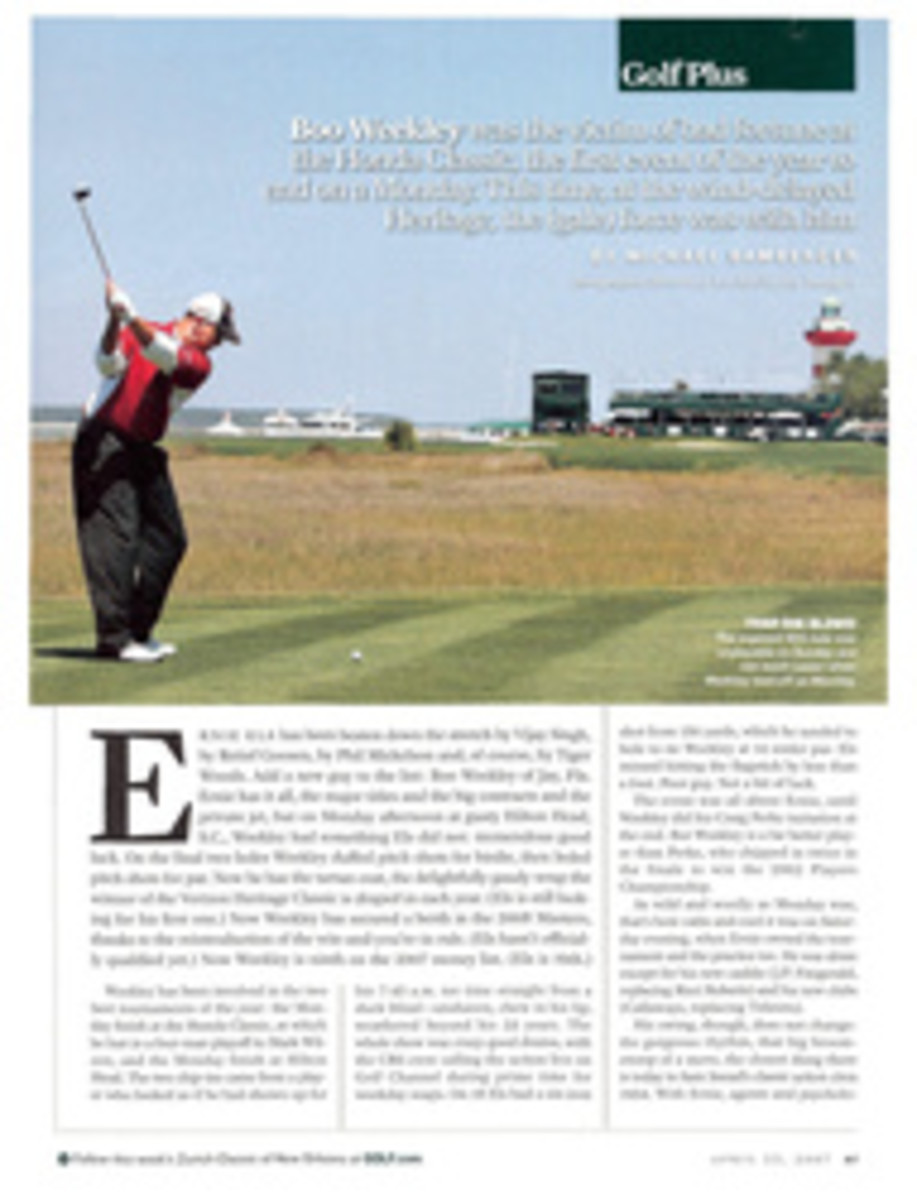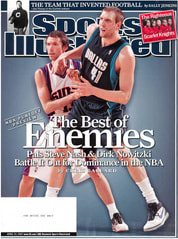
Deadly Bolts
The late-afternoonsun slants low through the Osage orange trees off the 7th hole at InniscroneGolf Club, burnishing the bunkers with a soft, warm, wintry glow. Here in themushroom country of Pennsylvania, these mock orange trees--battered by wind andscarred by lightning--flank the fairway like wounded veterans in a memorialparade for some forgotten hero. ¶ Ripening "monkey brain" fruit hungoff the branches two summers ago when John Needham popcorned a tee shot pastthe trees. The 45-year-old contractor was competing in a charity scramble tobenefit the Tick Tock Early Learning Center in Avondale. It had been raining,but now the skies seemed to be brightening as Needham, a passenger in a cartdriven by his partner, John Skross, pulled up to a bunker. Needham stepped outand leaned down to pick up his ball. At that instant there was a flash oflightning and a deafening boom of thunder. The blast of electricity knockedSkross off his feet and hurled him through the air. Needham crumpled to theground. "The bolt was two inches wide and about as white as could be,"recalls Buford (Boots) Wilcox, another member of the foursome.
The lightningmelted the gold chain around Needham's neck, fusing liquefied metal to theskin. His heart stopped. Skross and Matt Maloney, the group's fourth player,began CPR, but attempts to revive the fallen golfer failed. He was taken to anearby hospital, where he was declared DOA. "It was a real freak ofnature," says Wilcox. "On the news that night, Hurricane Schwartz, ourlocal TV weatherman, said the bolt that hit John at Inniscrone was the only onein Chester County that day."
Of all sports,golf may be the most vulnerable to lightning. To a lightning bolt, a golfcourse is an open field. And a human being, particularly one holding a metalclub, is a ready lightning rod. On top of that, the game is played among treesand water, both of which attract lightning.
Lightning kills anaverage of 100 people and injures 500 annually in the U.S. Five percent of thecasualties occur on golf courses. Major championship winners Lee Trevino, BobbyNichols and Retief Goosen are among those who survived strikes with relativelymild physical complications.
Trevino andNichols were fried almost simultaneously during the 1975 Western Open inIllinois, prompting the Merry Mex's famous crack: "I should have held up aone-iron. Not even God can hit a one-iron." Eleven years later Goosen, thena 17-year-old amateur, was nearly killed by a strike in his native South Africathat left him with an irregular heartbeat, diminished hearing and a pile ofscorched clothes he still keeps in a drawer. All three pros are thankful forgetting a mulligan in life.
Needham wassquatting on the berm of a hill when that fatal bolt struck him in 2005."Around here, we have a saying: Everyone has a lifetime clock," saysWilcox. "It doesn't matter what you're doing or where you are, when yourtime comes up, death is going to get you. Even on the 7th fairway."
The million-voltbolt of energy that zapped Jerry Heard on June 27, 1975, at Butler NationalGolf Club in Oak Brook, Ill., not only shocked his central nervous system butalso short-circuited his PGA Tour career. One of the most consistent players inthe sport, he spiraled down like a Titleist circling a cup. Today, at 59, thegolf he plays is mostly at night, in his dreams.
"I play a lotwith Jack Nicklaus," says Heard, who had won four tournaments in the sixseasons before the lightning struck. "Not beating him, just competing."Heard will be on the tee but unable to find a place to put his ball in theground; there's always something in his way. Or the Golden Bear will be callinghis name on the tee--it's always the 1st tee at Riviera Country Club, way up atthe top of a big hill--and Heard can't get there. Or Heard has too many clubsin his bag and he's frantically pulling them out. "Weird stuff," hesays. "Nothing like making a 40-footer to win the U.S. Open. I don't havethat one."
Heard's nightmaresbegan in '75, when he and Trevino were huddled under an umbrella on the edge ofthe 13th green at Butler National, by Teal Lake, waiting for a shower to pass.It was the second round of the Western Open, and the skies overhead were sunnyand clear. Suddenly, lightning from a distant thunderstorm flashed sidewaysacross the water and threw the two golfers into the air.
Golf's mostinfamous lightning bolt had surged through Trevino's bag and up his arm beforeexiting out his back. This was the second time Trevino had been lit up whileplaying golf. In case you were wondering, the odds of being struck are roughlyone in 700,000 in a given year and one in 5,000 over the course of an 80-yearlifetime. The chances of getting hit twice? One in nine million.
Heard's point ofentry was his groin, on which the tip of his umbrella rested. (On the otherside of the lake, Nichols and Tony Jacklin were hit by a separate bolt.) Heardfelt every muscle in his body roll up like a party favor. His hands clenchedand he couldn't open them. Heard had been so confident of his talent that heonce joked he could fall out of a car on the 1st tee at the start of everytournament and still make $100,000 a year. After being struck he told himself,"I'll never play golf again."
Trevino andNichols spent two nights in the hospital. (Jacklin suffered only ringing in hisears.) Because flooding on the course caused play to be suspended, Heard hadall day Saturday to recover and by Sunday he felt well enough to continue.Amazingly, he shot 72--73 to finish fourth, five strokes behind winner HaleIrwin. Heard didn't realize the extent of his injuries until four weeks later,at the Canadian Open. There Trevino told him, "My back's reallyhurting."
"So'smine," Heard replied.  They saw the same specialist, but while Trevinoopted for back surgery, Heard got a second opinion: Rest and hope for the best.He did.
Eventually, Heardwas bedridden for three months and sat out most of the '76 season, during whichhis wife divorced him. He returned to the Tour in '77 and played in pain,trying to find a swing that didn't hurt. His back went out while he was playingin Japan. In the months that followed he grew fat and irritable. "I used towake up and be in a good mood," he says of the days before he was injured."Then I started waking up and my back hurt."
As it turned out,the lightning had damaged Heard's spinal cord and cauterized nerve endings inhis tissues. Despite constant twinges, he won the '78 Atlanta Golf Classic. Hestill couldn't get through a full shot, so he hit slap-hooks around AtlantaCountry Club, but he made a bunch of putts and finished 19 under. Figuring thevictory was a fluke, Heard finally had the operation that had helped Trevino."It relieved a lot of aches," Heard says.
Trevino won ninemore tournaments on the PGA Tour, but Heard never regained his form. Hecouldn't hit a cut the way he used to, and he had never been good at tinkeringwith his swing, even in his prime. "Jerry was a guy who played veryinstinctively," says Nicklaus. The once preternaturally cocky Heard becameafraid to swing. He quit the Tour in 1980. Three years later, broke and livingin North Carolina, he heard about an opening as director of golf at South SeasPlantation on Captiva Island, Fla. Heard used a friend's credit card to callthe club, then borrowed cash from his parents to pay his airfare to Florida. Hewas hired and stayed for almost two decades.
Few lightningstorms have swept over a major championship tournament with such frighteningintensity as the one that disrupted the 1991 U.S. Open. The sky, implacable,walked on stilts of rain, and forked lightning splayed theatrically on openingday at Hazeltine National in Chaska, Minn., near Minneapolis. More than 40,000people were on the heavily wooded course when the rain started falling inswaying curtains, and many took cover under the trees.
A half-dozenspectators stood side by side under a 30-foot weeping willow near the 11th tee,one of the lowest spots at Hazeltine. "With its canopy, that willow lookedlike a great umbrella," says Ray Gavin, one of the six. "When I wasrunning to the tree, I saw lots of people under a giant oak and hundreds morewho refused to leave the metal bleachers. I thought, Those fools are going toget hit by lightning."
Two quick cracksof thunder later, Gavin and the others under the willow fell like duckpins."Actually, we didn't fall," says Gavin's friend John Hannahan. "Wemelted." A bolt had deflected off the tree and jumped to the sixbystanders. The lightning had penetrated Gavin's shoulder and exited throughhis hip. It came into Hannahan through one foot and came out through theother.
Gavin, now a65-year-old retired sales manager, was knocked unconscious. When he came to,paramedics were putting him on a gurney. "It dawned on me that from theneck down, I couldn't move," he says. "Not my toes, not my feet, not myhands. I thought I was paralyzed. I thought, My God, I'm going to be a burdento my family forever." Happily, the feeling in his body returned within sixhours.
Hannahan, a59-year-old real estate appraiser, remembers looking out on the 16th fairway.Then came a bright light. And a hollow expression on the face of the young manlying nearest the willow's trunk. That man was Billy Fadell, a computertechnician whose father had worked as a course marshal the day before. Fadell,28, was pronounced dead at a nearby hospital, the first-ever lightning fatalityat a PGA Tour--sanctioned event.
Meanwhile,Hannahan's heart had stopped, but he was revived by a volunteer fireman at thescene. Hannahan wasn't totally conscious until he woke up in an emergency room45 minutes later. "I looked at the end of the bed and saw my priest, mydoctor and my wife," he says. "I thought, This is not good."
Heard, too, hasdeveloped a dark sense of humor. For the last six years he has been part ownerof Silverthorn Country Club, the hub of a retirement community in southwestFlorida. Most days after work, he fishes for bass in the water hazard on the9th hole with his schnauzer, Miles. "Jerry could've been a superstar,"Trevino once said, but Heard says he could happily spend the rest of his daysmixing it up with his members, fishing with Miles and dreaming of Nicklaus.There's just one thing, he says. "We get a lot of lightning here."
• Read Alan'sShipnuck's Hot List at GOLF.com
Heard plays mostly at night, in his dreams. "I playa lot with Jack Nicklaus," he says. "NOT BEATING HIM, JUSTCOMPETING."
PHOTO
JACQUELINE DUVOISIN
DANGER ZONE In the U.S., 5% of the 100 deaths and 500 injuries caused annually by lightning occur on golf courses.
PHOTO
TWO PHOTOS
BETTMANN/CORBIS (2)
CLOSE CALL Nichols spent two nights in a hospital after being struck during the second round of the 1975 Western Open.
PHOTO
FRED VUICH
MAJOR FLASH At the '91 Open, about 40,000 fans were exposed.

